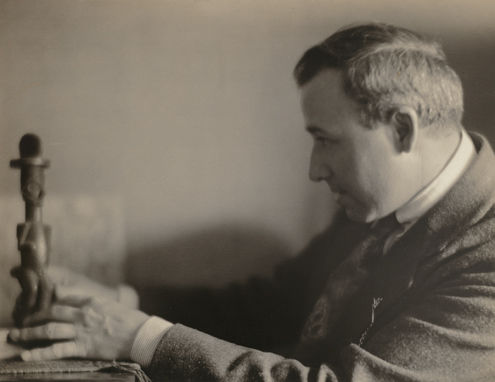African Art, New York, and the Avant-Garde
November 27, 2012–September 2, 2013
An Appreciation for African Art
"It is through great audacity in taste that we have come to consider these African idols as real works of art."—Guillaume Apollinaire, in A propos de l'art des Noirs, 1917

Clara E. Sipprell (American, born Canada, 1885–1975). Portrait of Max Weber,
ca. 1916. Gelatin silver print, in original exhibition mat. Museum of
Fine Arts, Boston, Museum purchase with funds donated by Hope and
Charles Hare and Kyle and Thomas Einhorn (2005.301)
At the start of the twentieth century, the appreciation of African
artifacts in the West shifted dramatically: from colonial trophies and
ethnographic specimens, they became modernist icons worthy of aesthetic
contemplation. Well established is the role played in this
transformation by modern European artists such as Pablo Picasso, André
Derain, and Henri Matisse, who began collecting African art about 1905,
finding in its bold shapes a source of inspiration. Lesser known, but no
less constitutive to the recognition of African material culture as
fine art, is the history of its reception in America over the subsequent
two decades. New York emerged as a new platform for modern art after the groundbreaking 1913 International Exhibition of Modern Art, better known as the Armory Show, which opened the door to dynamic transatlantic art commerce. This surge was bolstered in the summer of 1914 with the outbreak of World War I, which provoked the displacement of the art market's epicenter from Paris to New York. Numerous galleries opened in New York that year, and all sought to acquaint their audience with the newest European trends—including African art.
Consequently, while the European avant-garde was first exposed to African artifacts in ethnographic displays tied to colonialism, its counterpart in New York first saw such objects within contexts that underscored their association with abstract art. In New York more than anywhere else, juxtapositions of African art with works by Picasso, Constantin Brancusi, and Francis Picabia, in both galleries and private salons, were systematic, impacting until today the popular imagination to the point of obliterating its original context.
Unfolding both chronologically and thematically, this installation explores the multifaceted circumstances surrounding the reception of African art in conjunction with American modernism, from the initial 1914 exhibitions of African art in New York to the African American engagement inspired by Harlem Renaissance luminaries during the second half of the 1920s.
No comments:
Post a Comment